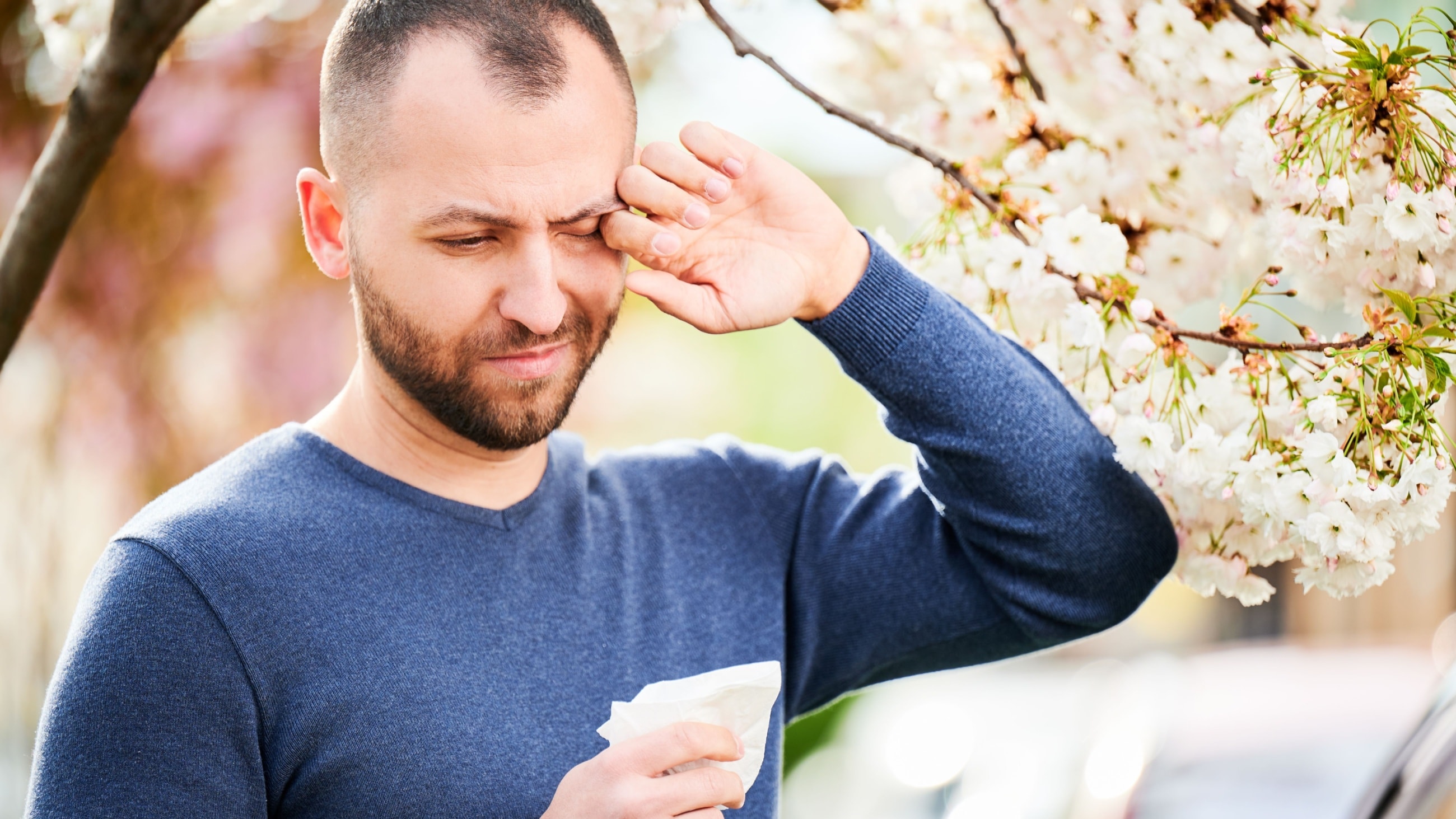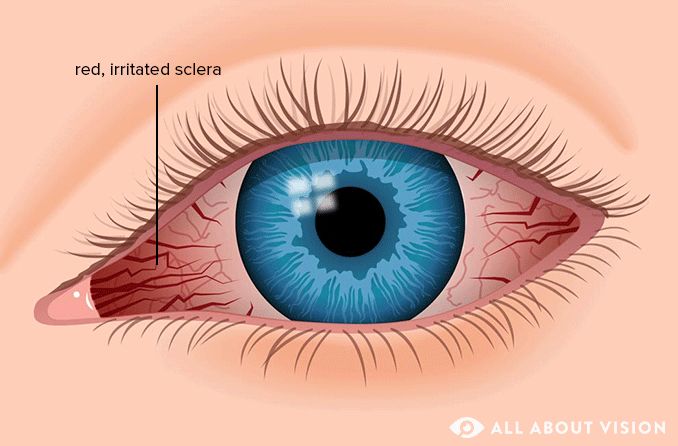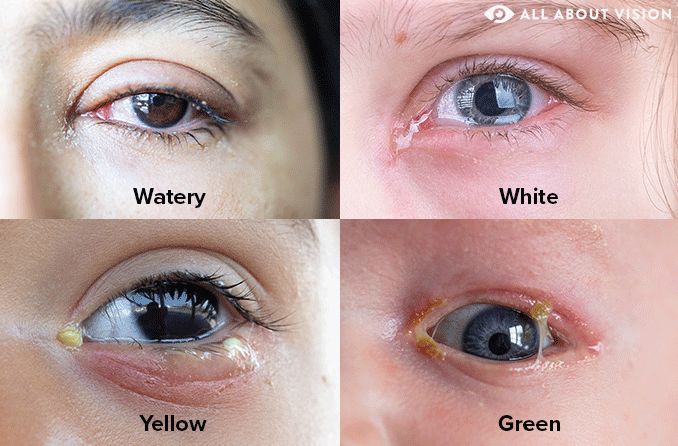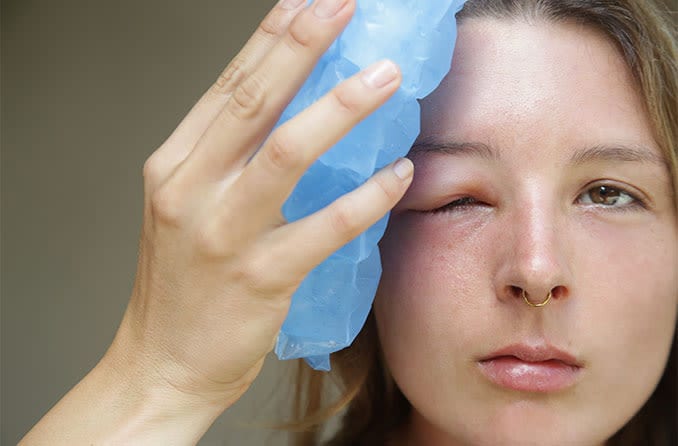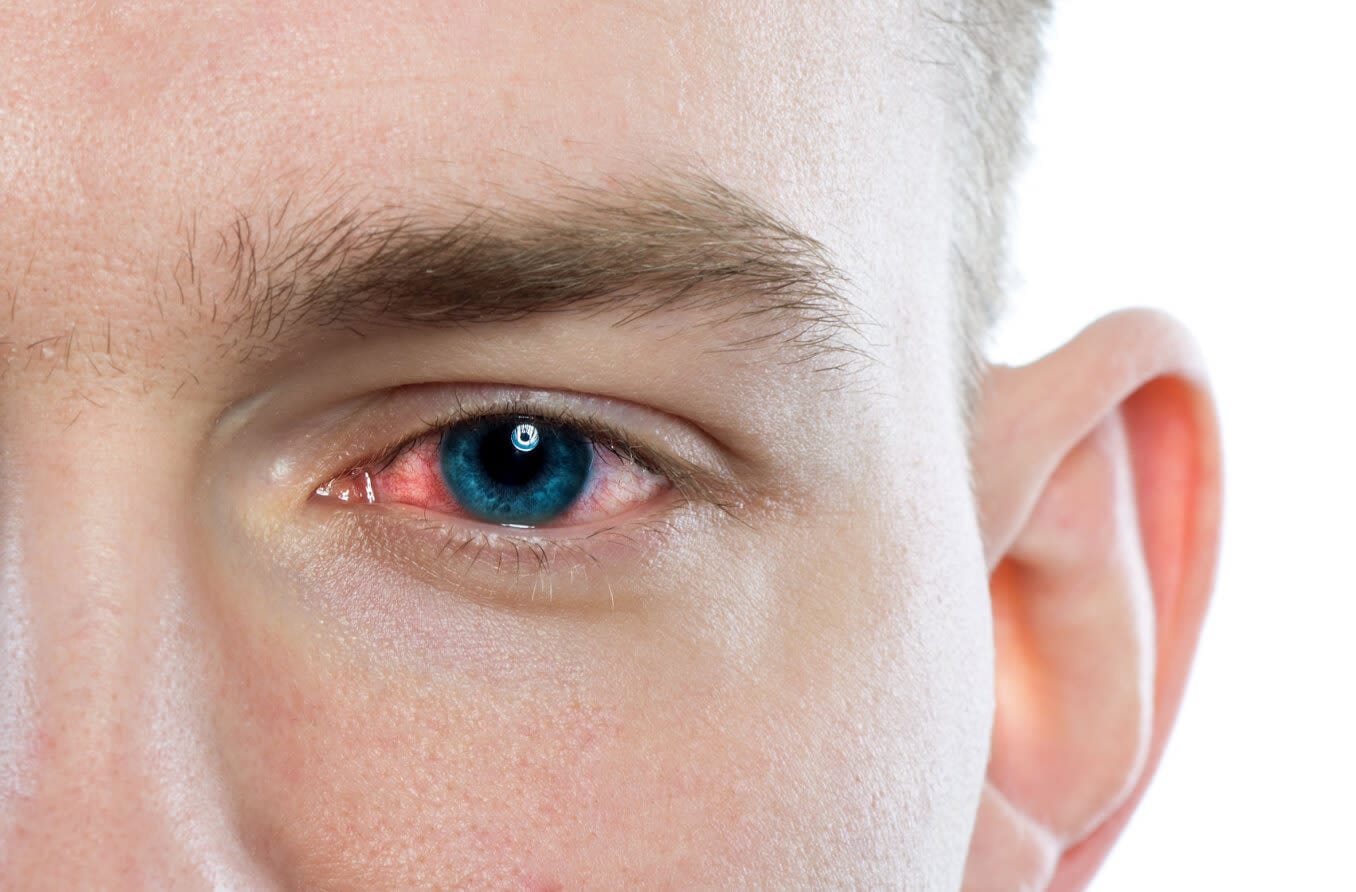Understanding eye allergies vs. pink eye
Eye allergies and pink eye (conjunctivitis) are conditions that share many of the same symptoms, such as red, itchy and watery eyes. Because of their similar appearance, it can be difficult to tell them apart. Understanding their differences can help ensure you get the right care.
Conjunctivitis is the general term for when the conjunctiva becomes inflamed. This is the thin membrane covering the inner surface of the eyelids and the sclera (the white of the eye). The condition is called “pink eye” because the inflammation causes the white of the eye to appear red or pink.
Infections, chemical irritants, tear production or evaporation issues, and allergens are the primary causes of conjunctivitis. When allergens are responsible, the condition is referred to as allergic conjunctivitis or eye allergies.
Causes and symptoms of pink eye
There are different types of conjunctivitis (pink eye). Each type is caused by specific factors and can produce distinct symptoms. In general, common symptoms of pink eye include:
- Eye redness
- Eye discharge (may be clear, white, yellow or green, and watery or thick in consistency)
- Crusting on the eyelashes or eyelids
- Watery eyes
- A gritty feeling (like sand is in your eye)
- Eye pain, itching or burning
- Light sensitivity
- Eyelid swelling
- Blurry vision
Types and causes
Conjunctivitis can affect people of all ages and may develop in different ways. The types of conjunctivitis are named for their underlying causes and include:
Viral conjunctivitis
This is the most common form of pink eye. While often caused by viruses that lead to the common cold, it can also develop from adenovirus, influenza and other viral conditions.
Viral conjunctivitis is the most contagious type and can easily be transmitted between people. It may affect one eye first and then move to the other.
Common symptoms of viral pink eye include redness, eyelid swelling and discomfort. It can also cause a thin, clear, watery discharge; light sensitivity; and a gritty feeling in the eyes.
Bacterial conjunctivitis
This type is caused by a bacterial infection. Streptococcus pneumonia, Staphylococcus aureus and Haemophilus influenzae are among the most common culprits, though others can be involved. Bacterial conjunctivitis is contagious and can affect one or both eyes.
Bacterial pink eye symptoms often include redness, eyelid swelling and discomfort. It also tends to produce a thicker green or yellow discharge and can cause noticeable crusting around the eyelids and lashes.
Chemical conjunctivitis
This type of pink eye, also called “toxic pink eye,” results from exposure to an irritant, such as:
- Air pollution
- Smoke
- Fumes
- Harmful liquids
- Other chemical substances
It’s not contagious and can affect one or both eyes.
Chemical conjunctivitis can cause symptoms like eye pain, redness, swelling and a decrease in vision.
Keratoconjunctivitis sicca (KCS)
KCS, also called dry eye syndrome, occurs when the eye doesn’t produce enough tears or the tears evaporate too quickly. This leads to inflammation of the cornea (the clear structure at the front of the eye) and the conjunctiva. Its signs and symptoms often overlap with those of general dry eye and can include:
- Eye irritation and redness
- A burning or stinging sensation
- A gritty feeling (as if something is in your eye)
- Watery eyes
- Blurry or fluctuating vision
- Pain or pressure around the eye
While KCS is typically not infectious, it can lead to corneal infections or other complications. It usually affects both eyes at the same time.
Causes and symptoms of eye allergies
Allergic conjunctivitis (eye allergies) occurs when the conjunctiva becomes inflamed due to environmental factors, such as when allergens cause a reaction in the eye. Common allergens include:
- Dust mites
- Mold
- Pollen from grass, weeds and trees
- Pet dander
It can also result from long-term exposure to a foreign body in the eye, like a contact lens.
This type of conjunctivitis is not contagious and typically affects both eyes at the same time. General symptoms include:
- Eye redness
- Intense eye itching (that often leads to eye rubbing)
- Watery eyes
- Clear or white stringy eye discharge
- Eyelid swelling
- A burning sensation
Other allergy symptoms, like sneezing, nasal drainage or nasal congestion, may also occur.
Types
Eye allergies can affect people in different ways, based on the types of allergens or factors that trigger a reaction. Allergic conjunctivitis is often grouped into the following general types:
Seasonal allergic conjunctivitis (SAC)
This form is associated with allergies that flare up during certain seasons, such as spring, summer and fall. Common seasonal allergens include outdoor substances like pollen from grass and other plants.
Symptoms often include redness, watery eyes, itching and/or a burning sensation. People with SAC may also have symptoms like sneezing, a runny nose and nasal congestion.
Perennial allergic conjunctivitis (PAC)
PAC develops from allergies that affect people year-round. Common triggers include indoor and household allergens like mold, dust and pet dander.
Symptoms are generally the same as with seasonal allergic conjunctivitis. However, they may be less intense.
Giant papillary conjunctivitis (GPC)
While technically not a true allergy, this condition is often categorized as a type of allergic conjunctivitis. It results from having a foreign body in the eye for an extended time, such as a contact lens.
Symptoms can include watery eyes, itching, mucus eye discharge and eye swelling. Blurry vision and a foreign body sensation (feeling as though something is in your eye) may also occur.
LEARN MORE: Symptoms of pink eye based on conjunctivitis type
Eye allergies vs. pink eye: Key differences
The main differences between eye allergies and pink eye are their causes, signs and symptoms, and whether or not they’re contagious:
Causes:
- Eye allergies – Caused by environmental allergens.
- Pink eye – Caused by infectious pathogens, such as bacteria and viruses, issues with tear production or evaporation, or chemical irritants (in the case of chemical conjunctivitis).
Signs and symptoms:
- Eye allergy signs and symptoms – Often include eye redness, intense itching and watery eyes. Sneezing or other nasal symptoms may also occur. Eye allergies tend to affect both eyes at the same time.
- Pink eye signs and symptoms – Often include eye redness and discomfort. Bacterial conjunctivitis may lead to yellow or green eye discharge, while viral conjunctivitis usually produces a watery, clear discharge. Viral and bacterial pink eye can affect one or both eyes (typically starting in one then spreading to the other), whereas chemical pink eye usually only affects the eye exposed to the irritant.
Contagious vs. not contagious:
- Eye allergies (allergic conjunctivitis) – Not contagious
- Viral and bacterial pink eye – Contagious
- Chemical conjunctivitis – Not contagious
- Keratoconjunctivitis sicca – Not contagious
It’s important to visit your eye doctor if you have symptoms of eye allergies or pink eye. They can determine which condition you have and provide the appropriate care.
Treatment options for pink eye
Treatment for pink eye can vary depending on the underlying cause. Before treating it, your eye doctor will need to determine what type you have.
Pink eye can be diagnosed through an eye exam, which includes evaluating the conjunctiva and other eye structures. Your eye doctor will also review your symptoms and any contributing factors.
Once your doctor determines the cause (and type) of pink eye, they can recommend the appropriate treatment, which may include:
Viral pink eye treatment
Like other viral illnesses, viral conjunctivitis is not treated with medications like antibiotics. In some cases, treatment with povidone-iodine can shorten the duration of the infection. Other treatment involves taking steps to relieve symptoms until the virus resolves on its own, typically within three weeks. Symptoms may be managed by using artificial tears, cool compresses or topical steroids to help control inflammation and discomfort.
Bacterial pink eye treatment
Bacterial pink eye is typically treated with topical medication, such as antibiotic ointments or eye drops. While symptoms usually start to subside after a few days, it’s important to finish the entire antibiotic regimen to fully treat the infection.
Chemical pink eye treatment
Pink eye caused by a chemical irritant is usually first treated by flushing the eyes. Topical steroids may be prescribed to help control inflammation and discomfort.
Severe cases or symptoms may require additional medical care, as certain chemicals can cause significant damage to your eyes and/or vision.
Keratoconjunctivitis sicca treatment
Treatment for KCS aims to relieve dry eye symptoms. Some of the most common treatment options include:
- Artificial tears to keep the eyes moist
- Anti-inflammatory drops to relieve dryness-associated inflammation
- Tiny plugs to block the tear ducts and keep more tears available on the eye’s surface for longer
Treatment options for eye allergies
If your doctor determines that you have allergic conjunctivitis, they may recommend one or more of the following options to help you experience relief:
- Over-the-counter (OTC) medications – These may include nonprescription eye drops, such as artificial tears, antihistamines, mast cell stabilizers and decongestants, or oral antihistamines. (Follow your doctor’s recommendations for using any OTC medications.)
- Prescription (Rx) medications – Eye drops may include antihistamines, mast cell stabilizers, non-steroidal anti-inflammatory drugs (NSAIDs) and corticosteroids. Oral antihistamines and allergy shots may also be prescribed.
Antihistamine eye drops address immediate itching while mast cell stabilizers help prevent future reactions. Most allergy eye drops available — both Rx and OTC — are a combination of antihistamines and mast cell stabilizers.
Prevention tips for eye health
While you may not always be able to prevent pink eye and eye allergies, you can take steps to reduce your risk and help maintain your eye health.
To help protect your eyes from pink eye:
- Avoid touching your eyes as much as possible.
- Wash your hands often and thoroughly with soap and water, especially before touching your eyes. Use an alcohol-based hand sanitizer (with at least 60% alcohol) if you don’t have access to soap and water.
- Avoid sharing personal items, such as makeup, towels, pillowcases, glasses and eye drops.
- Avoid exposure to toxic fumes and other substances that could cause chemical conjunctivitis. Be sure to wear protective eyewear when working around chemicals or other irritants.
- Avoid exposure to known cases of infectious pink eye. Use proper disinfection techniques on surfaces that may have been exposed to the infection.
You can help reduce your risk of developing eye allergies by adopting the following environmental strategies:
- Avoid allergens that tend to cause symptoms.
- Wash your hands thoroughly with soap and water after coming into contact with any known or potential allergens.
- Reduce the amount of time you spend outdoors when pollen counts are high.
- Keep your car and house windows closed during peak pollen seasons.
- Limit your exposure to dust and mold.
- Wash bed linens often and in hot water.
- Maintain low humidity in your home to help reduce mold growth. Consider using a dehumidifier in damp environments.
- Avoid exposure to pets if you are (or may be) allergic to them.
- Wear contact lenses exactly as prescribed. Be sure to follow the recommended cleaning and storing protocols for your contacts.
Your eye doctor can also help you determine the best ways to reduce your risk of developing these conditions.
When to see a doctor about eye allergies or pink eye
Eye allergy and pink eye symptoms can mimic those of other conditions, some of which are more serious. If you experience eye redness, itching, pain or other symptoms, schedule an appointment with your eye doctor as soon as possible. They can ensure you get a timely diagnosis and the right type of care for your eye and vision needs.

